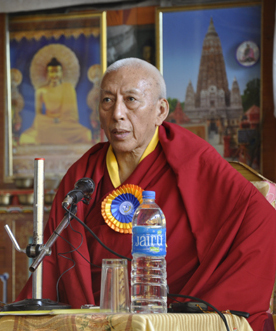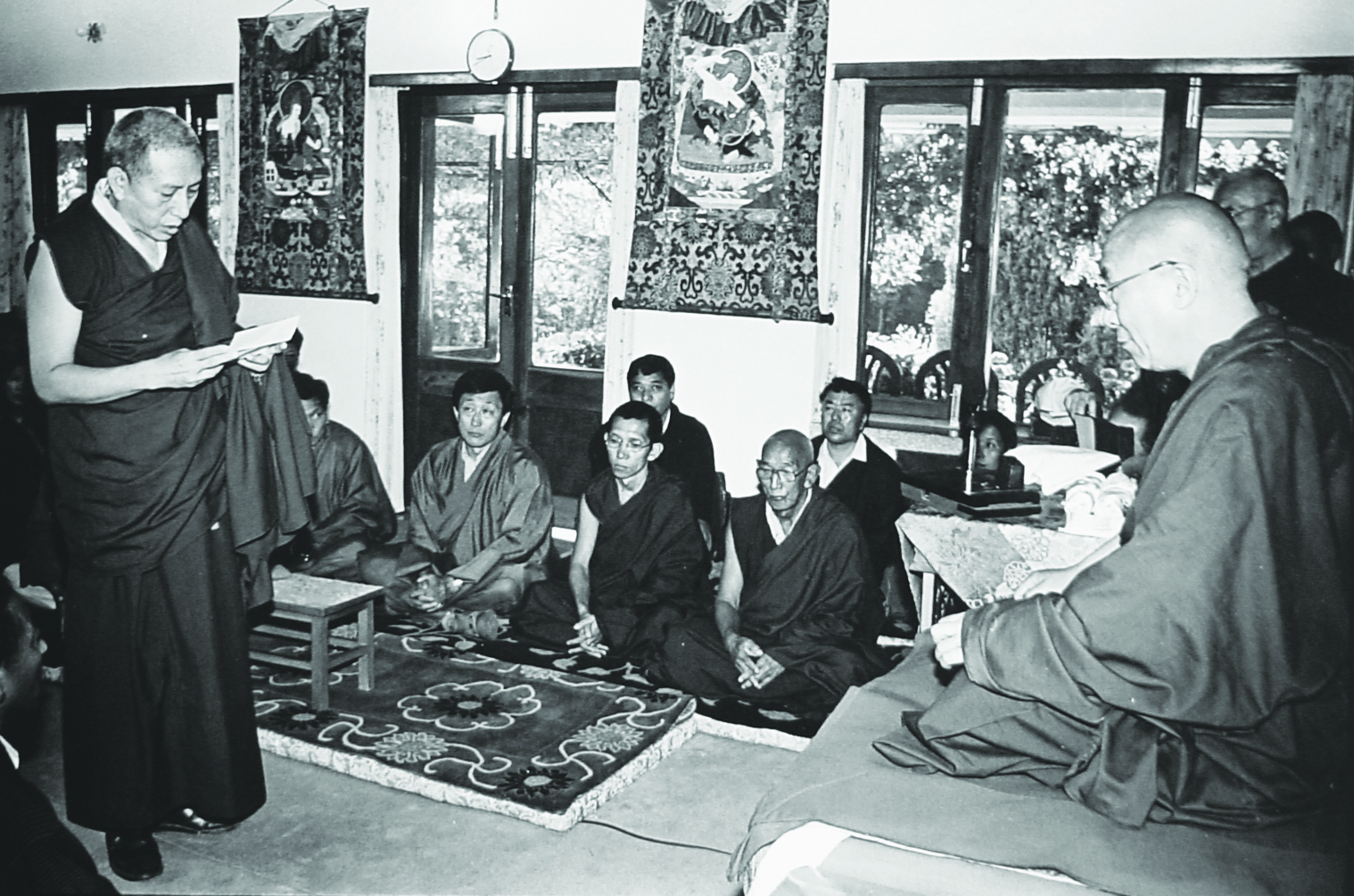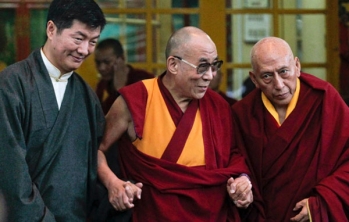Key Vocabulary Terms:
- Central Tibetan Administration (CTA):The official title for the government-in-exile, based in Dharamshala, India.
- Tibetan Parliament-in-Exile (TPiE):Formerly known as the CTPD or ATPD, this is the 44-member Parliament that is the highest legislative branch of the CTA.
- Speaker and Deputy Speaker:Formerly known as the Chairman and Vice Chairman, these leaders are the heads of the TPiE. Currently held by Penpa Tsering and Lopon Khenpo Sonam Tenphel.
- Kashag:The Cabinet, the highest executive office of the CTA. Made up of a maximum of seven ministers, each responsible for a different department within the government.
- Sikyong: Formerly known as the Kalon Tripa, this is the main Tibetan political leader, Chief Executive of the Cabinet. Currently held by Dr Lobsang Sangay.
- Kalons:Individual ministers who make up the Kashag (Cabinet) and are responsible to the Tibetan Parliament-in-Exile. The group of Kalons is led by the Sikyong.
- Charter of the Tibetans in Exile:Supreme law adopted by the TPiE in June of 1991, governs the functioning of the CTA and outlines the rights and responsibilities of Tibetans in exile.
This October, Tibetans all over the world will start the process of voting for the leader and figurehead of the Tibetan people: the post of Sikyong, and the people who make up their government-in-exile.
The October election will be the preliminary election for the Sikyong of the 15thKashag and members of the 16th Tibetan Parliament-in-Exile (TPiE). Although this process is now done democratically, it has not always been that way. Since the establishment of the Tibetan government-in-exile in 1960, this institution has evolved dramatically to become the functioning parliament that is active today.
Before coming to India, the Tibetan people had little experience of a democratic system of government, as their Tsogdu (National Assembly) was appointed without direct election. Shortly after becoming established in exile, the Dalai Lama made it clear that a democratic system of government would be the best course of option for the Tibetan people. On September 2, 1960, the first elected group of representatives was established as the Commission of Tibetan People’s Deputies (CTPD), following His Holiness’s guidelines for an elected body of 13 representatives, including three from each province of Tibet and one from each of the four schools of Tibetan Buddhism.
The next major milestone in the development of Tibet’s government-in-exile was the creation of a constitution. The following year, the Dalai Lama drafted a constitution and asked for suggestions and improvements from the people. The document was notable for incorporating both traditional Tibetan values as well as more modern democratic principles, and helped to set more structural guidelines regarding governmental positions and elections. The constitution was adopted in March of 1963.
In the mid-1970s, the Commission was renamed, becoming the Assembly of Tibetan People’s Deputies (ATPD or “the Assembly”). In addition, the term of Kalons (Cabinet Ministers) was fixed for five years, a precedent which is still in place today.
Throughout the second half of the 20th century, the Dalai Lama, while still instrumental in the election process, continued to stress the importance of achieving a fully democratic system of government and limiting his own political authority. He wanted the Tibetan people to become more educated about democracy, and eventually to elect both a head of government and the members of the ATPD entirely on their own.
The Tibetan refugee community consistently resisted the Dalai Lama’s efforts to withdraw from political leadership, but in 1990 His Holiness announced his official renunciation of the supreme authority to elect Kalons and to supervise the government-in-exile. He provided guidelines for expanding the ATPD membership, electing Kalons democratically, and creating a judicial branch to hear complaints from the Tibetan people. He also established a Constitution Review Committee tasked with drafting a democratic charter for the government-in-exile.
Just one year later, Assembly membership had nearly quadrupled in size, rising from 12 to 46 members representing all areas of Tibet, all schools of Buddhism, and the continents of Europe and North America. The Charter of the Tibetans in Exile was adopted in June of 1991 and provided the first guidelines for the democratic election of Kalons. Furthermore, a Supreme Justice Commission was established to aid in interpreting the laws and hearing civil cases brought forth by the Tibetan community, and an Election Commission was created to oversee the election of the Kalons and ATPD members.
However, even after these major changes in the early 1990s, some political power was still exclusive to the Dalai Lama. Following his continued encouragement to establish a more legitimate democracy, His Holiness announced in 2001 that the position of Kalon Tripa would be directly elected by the Tibetans-in-exile. This change, from Kalon Tripa candidates being nominated by the Dalai Lama to being elected by the people, was one of the most significant democratic developments made by Tibet’s government-in-exile. However, the Dalai Lama still officially shared executive authority with the Kalon Tripa and had not been removed from the government entirely.
Professor Samdhong Rinpoche was the first democratically elected Kalon Tripa who did not need a nomination by His Holiness. He was appointed in April of 2001, having earned 80% of the vote. Upon election, the Professor nominated a selection of Kalons who were then voted in by the Assembly, marking the first government to be entirely appointed by the new system.
The government later underwent a few name changes to become the institutions that we know today. In 2006, the Assembly of Tibetan People’s Deputies became the Tibetan Parliament-in-Exile (TPiE), and the positions of Chairman and Vice Chairman of the TPiE were changed to become Speaker and Deputy Speaker, respectively.
After many years of slowly relinquishing his political position in the Tibetan community, on March 10, 2011, His Holiness officially announced that he was giving up all executive authority within the Central Tibetan Administration, citing a firm belief that this would benefit Tibetans in the long run. The TPiE responded by drafting a resolution, urging the Dalai Lama to remain as ceremonial head of the government-in-exile. Although he denied this request, His Holiness did agree to remain the official protector and symbol of the Tibetan nation.
The elections of the 15thTPiE and Kalon Tripa of the 14thKashag took place in March of 2011 and were the first to be held after the Dalai Lama’s departure from his political position. In May of the same year, the Charter was officially ratified to name the Kalon Tripa as the highest-ranking office holder, a status that this position still holds today. In September of 2012, the title of Kalon Tripa was changed, and this political leader is now known as the Sikyong.
Over the past half-century, the structure of the Central Tibetan Administration has undergone dramatic changes, most notably involving the expansion of the Parliament and the transfer of executive authority from the Dalai Lama to the Sikyong. Reforms aimed at promoting a more democratic system have been championed by His Holiness and, at times reluctantly, implemented by the Tibetan people. The upcoming election marks a chance for the community-in-exile to make their voices heard in a way that previously was not possible, which is ever more important in the context of a regime that is trying to silence them.
Keep up to date on election issues by following this link to our election news page: Election 2016








 Print
Print Email
Email